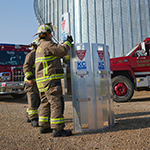5 dangers of confined spaces
Poor training and execution could lead to deadly mistakes.
There’s no getting around it — complying with the Occupational Safety & Health Administration (OSHA) confined space standard is a demanding undertaking. From record-keeping requirements, training, permits and a written program, the standard requires a lot of effort on the part of the safety professional.
But that’s no excuse for overlooking the dangers. That’s because mistakes surrounding confined space entry are often deadly. Sometimes oversights happen because workers don’t know the rules. Other times it’s when they choose shortcuts. In either case, our risk management services team has determined that serious accidents can often be traced to one or more key breakdowns in duties that represent the “Five Deadly Sins” of confined space entry.
1. Failure to monitor the confined space prior to, and during, entry
The Standard (1910.146 (d)(5)(i)) reads: “Test conditions in the permit space to determine if acceptable entry conditions exist before entry is authorized to begin...” And (d)(5)(ii) states: “Test or monitor the permit space as necessary to determine if acceptable entry conditions are being maintained during the course of entry operations…”
Simply stated, knowing the atmospheric conditions inside a confined space can mean the difference between life and death. No employee should enter until he/she is aware of the hazards present on the inside. Hazards include exposure to a toxic, oxygen-deficient/enriched or flammable atmosphere. Upon entry, it’s important to continue to monitor because atmospheric conditions can change quickly. Ideally, you’ll want to position the entrant near a monitor with an alarm capable of warning the person if conditions change.
2. Failure to remove hazards from a confined space
Standard 1910.146 (f)(8) - entry permit. The entry permit that documents compliance with this section and authorizes entry to a permit-required space shall identify: “…the measures used to isolate the permit space and to eliminate or control permit space hazards before entry. Those measures can include the lockout or tagging of equipment, and the procedures for purging, ventilating and flushing permit spaces.”
Before anyone enters a confined space, they must take steps to lockout energy hazards, double block and bleed lines that run into the space, ventilate the confined space if it contains a hazardous atmosphere and remove engulfment hazards.
3. Failure to account for hazards brought into a confined space
Standard 1910.146 (d)(3)(vi) states: “Verifying that conditions in the permit space are acceptable for entry throughout the duration of an authorized entry.”
Workers generally enter confined spaces out of a need to perform a task inside. This work often requires workers to carry tools into the space. Before doing so, you must consider what type of work is being performed to make sure that it will not create an unsafe environment. For example, welding tools and other spark-producing equipment should not be used in oxygen-rich environments or atmospheres above the lower explosive limit (LEL). Welding materials can also produce deadly carbon monoxide. Ventilation may be used and monitoring may be needed to ensure safety during these activities.
4. Failure to have trained rescue personnel onsite and standing by and to instruct non-rescue personnel to not enter the confined space under any circumstance
As indicated in 1910.146 (k)(1)(iii): “Select a rescue team or service from those evaluated that: Has the capability to reach the victim(s) within a time frame that is appropriate for the permit-required space hazard(s) identified; is equipped for and proficient in performing the needed rescue services; inform each rescue team or service of the hazards they may confront when called on to perform rescue at the site; and provide the rescue team or service selected with access to all permit spaces from which rescue may be necessary, so that the rescue service can develop appropriate rescue plans and practice rescue operations.”
Only rescue-trained personnel may enter a confined space to perform a rescue. Over 50 percent of confined space entry fatalities involve the rescuer, so it’s critical to prohibit entry of non-rescue trained personal into confined spaces.
Reliance on an outside party for rescue is a factor in an alarming number of confined space fatalities. Typically, the resource relied on are members of the local fire department—who unfortunately, are not always told that an entry is going to take place. It’s even possible for these responders to be unaware they’ve been assigned as the rescue team in the first place.
Survival for a worker who enters an oxygen-deficient or toxic atmosphere is dependent upon immediate rescue. Calling the outside party and notifying them once the entrant is in danger usually means one of two things: either the outside party arrives too late or an untrained coworker enters the confined space in an attempt to rescue the entrant. This often results in a second fatality. It’s important then to work with the rescue personnel prior to entry familiarize them with the space and determine the rescue equipment they may need in case of an emergency.
5. Failure to use a mechanical means of rescue
Standard 1910.146 (k)(3) says: “To facilitate non-entry rescue, retrieval systems or methods shall be used whenever an authorized entrant enters a permit space, unless the retrieval equipment would increase the overall risk of entry or would not contribute to the rescue of the entrant.”
When possible, the use of a tripod and hoist enables rescuers to remove the worker from outside the confined space without endangering the rescue team or others. Another key advantage is that rescue can be performed immediately after a hazard is recognized, and with the response team standing by, it increases the chances of a successful rescue.
Prepare for the worst
When dealing with confined space entry, we encourage you to err on the side of caution. Even minor confined space emergencies require prompt and effective action. However, if training and execution are inadequate, even a minor emergency could turn into a fatal incident.

 >
>

 >
>
 >
>